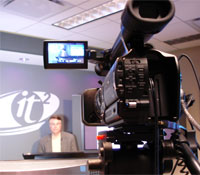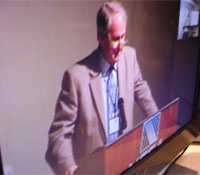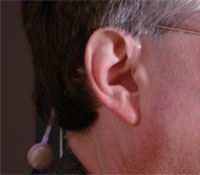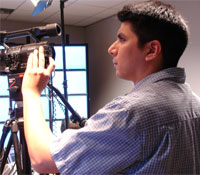CalViz Studio and New Optical Link Enable Smarr to Go ?Telepresent? to NCSA Industrial Meeting
By Stephanie Sides
|
San Diego, California, June 27, 2006 -- In a talk fittingly titled “Towards a Global Telepresence,” Calit2 director Larry Smarr participated “live” from the Calit2 CalViz High-Definition Telepresence Studio in a tribute to John Stevenson who’s retiring as director of NCSA’s industrial program. This event was held during the 2006 NCSA Private Sector Program Annual Meeting.
Smarr’s participation demonstrated an early use of the optical link now in place between Calit2 and NCSA to enable the latter to be persistently coupled into the 10-Gbps optical fabric that Calit2, the National LambdaRail, and CENIC are building out. Donna Cox, director of Visualization and Experimental Technologies at NCSA, worked with Smarr and the technical staffs in both locations to set up the demo (NCSA is an OptIPuter partner with Calit2). This technology was first demonstrated in March for a talk Smarr gave from Calit2 to listeners in Australia.
Speakers at this event included Riaz Abdulla (formerly of Eli Lilly) and Jim Bottom (former deputy director of NCSA; see photo below).
|
With regard to the technology that made Smarr’s presentation to NCSA possible, Smarr was videotaped with a prosumer HDV camera (1440 vertical lines x 1080 horizontal lines). The demo setup also featured a professional HD monitor to see and adjust the image coming from the camera on Smarr and a display of Smarr so he could see the image being sent to NCSA.
The video and audio signals were fed through a FireWire cable into a computer and processed with VLC software (an open-source media player that can handle transmission of any media), which applied compression algorithms and sent the result out over the network at about 25 Mbps. A computer on the other end applied the same software to decompress and present the signal. Because this system experiences a four-second round-trip latency (delay), which can be a bit jarring to interactive discussions, it’s as yet best for one-way presentation.
Smarr viewed and heard NCSA listeners via an H.323 videoteleconferencing system, which has a shorter latency -- about 300 milliseconds, which is almost instantaneous. The audio feed was fed through a mixer and routed to an earpiece Smarr wore but was, for all practical purposes, nearly invisible to the NCSA audience. With echo cancellation (not currently a feature of the VLC software), this allowed Smarr to hear NCSA without any distraction.
|
Small speakers with low sound levels enabled Hector Bracho, Calit2's new media specialist, and other technical team members to follow events at NCSA to know when to make Smarr go live. The technical staffs on both ends kept in touch with each other minute by minute via instant messaging.
“The most complicated thing about these setups is the sound,” said Bracho, “because Larry likes to play video clips with sound from his laptop. We also spent time lighting Larry properly. We used two lighting fixtures and experimented with the angles they were placed at to avoid shadows and reflections from the plasma panel where Larry was displaying his PowerPoints. We also had to position the camera so it didn’t pick up reflections of the light. Overall, from a technical standpoint, it took us about 45 minutes to set this demo up.”
|
Normally, with standard-definition video, the PowerPoint slides have to be sent as a separate data stream. (A computer signal is higher resolution than standard-definition video and, therefore, has to be sent separately.) High definition, on the other hand, has higher definition than the computer signal, allowing the high-definition camera to capture all the pixels of the plasma screen, making them readable to the audience on the other end of the link.
In addition to Bracho, the event was made possible by technical support at Calit2 provided by S. Helena Bristow, Jurgen Schulze, Qian Liu, and Ian Kaufman.
Toward a Global Telepresence: Summary of Larry Smarr's Presentation
“My presentation tonight is an example of how telepresence is going to change relationships materially among groups that want to communicate with each other,” said Smarr. “Amazingly, this type of capability was envisioned decades ago in the realm of science fiction, yet it’s only becoming possible today.” As an example, he pointed to the AT&T “Picturephone” introduced 40 years ago. “You can see it’s a very long road from vision to reality,” he said.
Then Smarr walked listeners through a series of technology breakthroughs to which he has contributed, most of which involved member companies represented at the other end of the link.
NCSA worked with AT&T and Sun Microsystems to “go for broke” in envisioning how technology and networking would begin to eliminate distance. Smarr and Cox foretold the future with a televisualization demo at SIGGRAPH in Boston in 1989, applying analog AT&T satellite dishes and Sun workstations to turn analog signals into digital video between Urbana-Champaign, IL, and Boston. “Now we can do this type of telepresence as a daily event,” said Smarr.
The next step was linking people around the country in a distributed virtual immersion environment using early tiled display walls called “PowerWalls.” This project, too, included a number of industrial partners, including SGI and Caterpillar; Smarr credited the latter with “having driven every stage of development in virtual reality at NCSA.” Within a year, they had demonstrated a proof of concept of the usefulness of such a distributed environment using a VR model of a tractor, linking collaborators in Peoria, Houston, and Germany.
Then NCSA worked with the State of Illinois to create the I-WIRE dark-fiber network. “This was no longer the shared Internet,” said Smarr. “People were captivated by the idea of opening a glass channel to a single investigator. Now there are more than two dozen state and regional networks with these kinds of capabilities, which, in turn, have given birth to the National LambdaRail and TeraGrid. It was like a throwback to 1985 when we began building out the Internet, but now we were considering speeds in the range of 10-40 Gbps.”
The shared Internet, Smarr reminded everyone, was established to feed a personal computer with tens of Mbps. But a thousand times that much data coming in over an optical network required “blowing up” the personal computer and, instead, designing an appropriate “terminating device.” So, as part of the OptIPuter project, Smarr’s team applied NCSA ideas with multiple video projectors to create, with LCDs, the OptIPortal.
“We experimented with sending pre-recorded video from the Electronic Visualization Lab in Chicago to Calit2 in San Diego, then live to NCSA,” said Smarr. “When you do this, you begin to see the power of pixels integrated with high-definition video. At that point it became clear we needed to integrate this visualization technology with optical networks.”
Smarr described the next key demonstration, which took place in August 2005, that leveraged newly established optical networks. This demonstration featured researchers at NASA Goddard clicking on a tiled wall at their facility in Maryland that solicited higher-resolution data from Calit2 and visualized it for them on the fly. Smarr showed an example tiled display wall in the CalViz studio, which is 5 displays wide by 4 tall and featured pre-recorded video from EVL.
The next stage was applying a link from StarLight in Chicago to NCSA over I-WIRE to integrate remote, interactive data visualizations to integrate 512-processor SGI workstations into the national (and becoming global) fabric of the OptIPuter. “We at Calit2 are trying to stay 15 minutes ahead of NCSA,” Smarr joked. “We’re now linking a 200-megapixel wall at UCI, a 100-megapixel wall here at UCSD, and a 40-tile projector wall at NCSA.
“Of course we’re never satisfied. Now we want to get to a billion pixels in a single image. In this scenario, the display is just a window into a larger, more highly resolved image hiding in the background but accessible at a second’s notice,” concluded Smarr. “What we’re demoing now at Calit2 will be yours at home in less than 10 years.”
This will take author Thomas Friedman’s notion of the “flat world” and reduce it to a single point. “That will cause a radical shift in how society is organized,” Smarr said.
Media Contacts
Stephanie Sides, ssides@ucsd.edu, (858)534-5131





